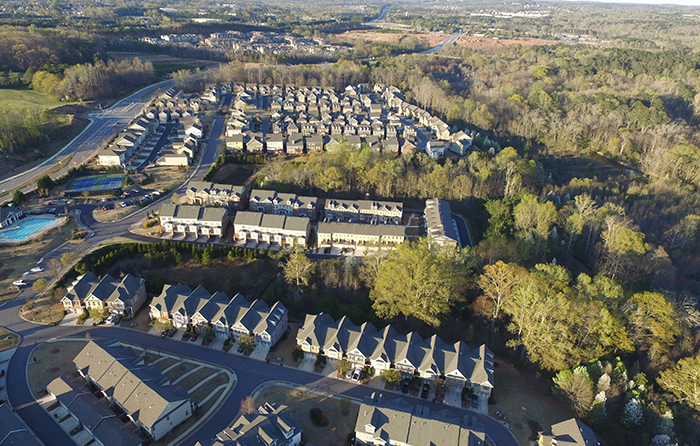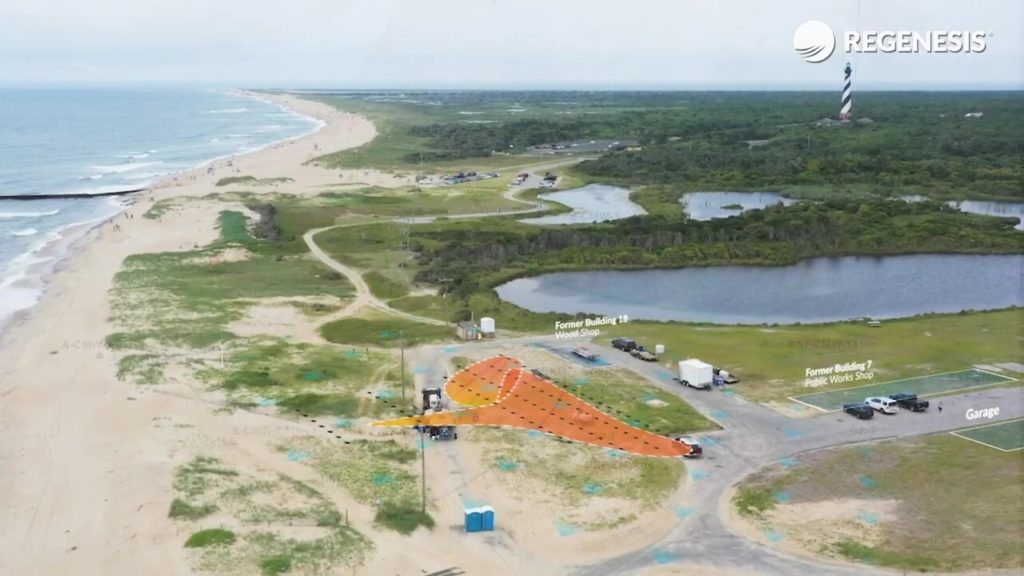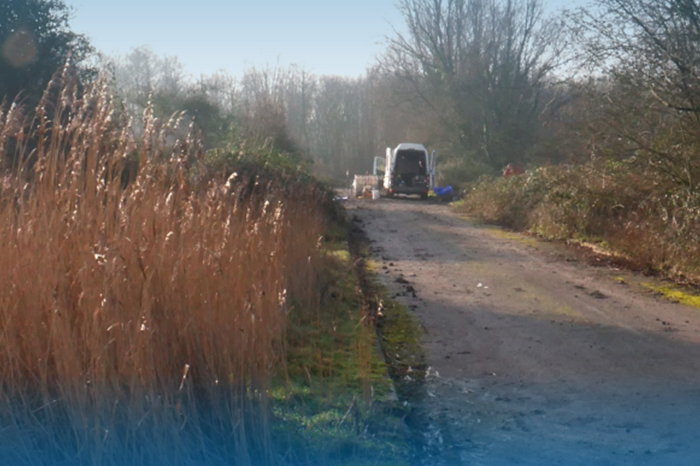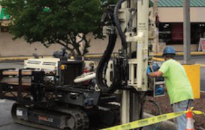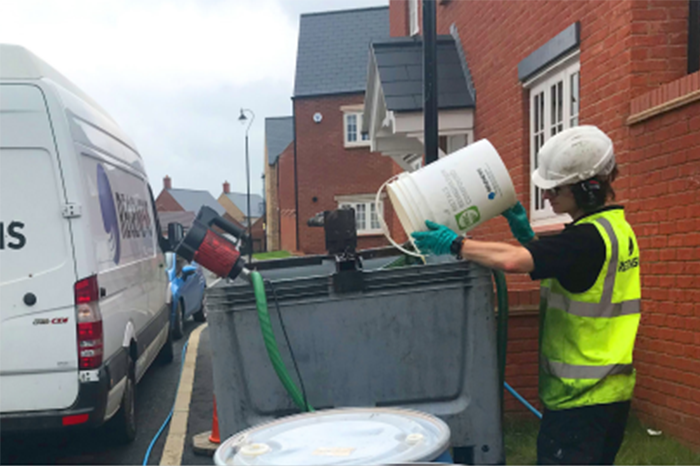Nitra-Seal Ensures Long Term Vapor Intrusion Protection for Quick Service Restaurant
Case study highlights:
- Quick service retail restaurant required an effective preemptive vapor mitigation solution to protect future employees and customers from potential vapor intrusion risks
- The project development team determined Nitra-Seal was the safest, most expedient and cost-effective vapor barrier system to install on this site
- Land Science Certified Applicator S&H Waterproofing and Construction, installed Nitra-Seal and performed smoke testing as part of the quality control process to confirm proper installation of the barrier.
This project development site is a newly opened quick-service restaurant in Conyers, Georgia. Offsite chemical spills from historical operations had resulted in low-level volatile organic compounds (VOCs) released to the subsurface, creating a potential for vapors to intrude into new buildings constructed in the affected area. Recognizing the risk and placing emphasis on future workers’ safety, the forward-thinking client decided that a preemptive measure be instituted, requiring the installation of a vapor mitigation system as part of the construction specification.
First Application of PetroFix at Petrol Filling Station in Sweden
Case study highlights:
- The integrated remediation treatment strategy ensured that optimum treatment efficiency was maintained throughout the phases of works
- The amount of excavation and offsite disposal was minimized
- All underground infrastructure remained in situ
- All works were completed at an active petrol filling station with minimal disruption to the commercial operations of the facility
- 12-month period monitoring results show reductions of >98% of the gasoline range of petroleum hydrocarbon concentrations in the groundwater
RGS Nordic was asked by Circle K to remediate groundwater contaminated with gasoline at an active Petrol Filling Station (PFS) in Nykvarn, Sweden. During the site investigation, petroleum hydrocarbon contamination was identified within the fill material around the underground storage tank (UST) farm.RGS Nordic was required to deliver a remediation strategy that posed minimal disruption to the commercial operations of the PFS. The chosen remediation strategy combined targeted excavation, in situ chemical oxidation (ISCO), in situ sorption, and enhanced aerobic biodegradation using a range of complementary REGENESIS technologies: RegenOx®, ORC-Advanced® and PetroFix®.
In Situ Remediation of CHCs within a Bedrock Aquifer, Germany
In Situ reagent barriers (HRC) treat contaminated groundwater in sandstone under a schoolRead More
Nitra-Seal Specified to Mitigate VOCs for Urban Atlanta Townhome Development
Case study highlights:
- Nitra-Seal protects future residents of new urban townhomes
- Total Vapor Solutions selected Nitra-Seal and TerraVent for this site after soil and gas samples revealed the need for a vapor intrusion mitigation system.
- It was determined that Nitra-Seal should be laid across every foundation, but ventilation needs were not uniform for all the buildings.
A leading national builder of luxury homes recently acquired a brownfield site in Midtown Atlanta with plans to develop a large-scale multi-phase townhome project. The developer planned to construct nine individual buildings on the site, each ranging from 4,000 to 6,000 square feet, with multiple townhouse units inside. Slab-on-grade foundations were set, but construction could not continue without understanding each building’s vapor intrusion risks and creating a plan to provide reliable protection for future residents.
PetroFix Chosen as Most Cost-Effective Approach
Case study highlights:
- PetroFix Remediation Fluid was chosen because it is specifically designed to treat PHC plumes stemming from bulk storage, gas station, and UST spills.
- The responsible party plans on closely monitoring the site and is using PetroFix on other CERCLA/RCRA-funded sites to accelerate site closure.
- The crew was able to make real-time adjustments to injection volumes, pressure, tooling, and locations to accomplish the distribution goals.
This case study reviews a PetroFix application to address hydrocarbon contaminants at the former Buxton Naval Auxiliary Air Station, located within the Cape Hatteras National Park in the Outerbanks region of North Carolina. The US Navy utilized the site as a submarine monitoring station from 1956 to 1982. The US Coast Guard (USCG) acquired the facility after 1982 and used the site as a logistical, communication, medical, and supply support center. The site contains four areas of investigation which encompass a total area of approximately 50,000 square feet. Since 2011, the site has been undergoing long-term monitoring. Although the monitoring shows natural attenuation occurring, persistent exceedances of petroleum hydrocarbons warranted additional remediation efforts. In the process of a thorough evaluation of viable remedies, the responsible party specified PetroFix micron-scale, liquid-carbon amendment to be applied to quickly and effectively address the contaminant levels and achieve their site goals of NFA.
In situ treatment of MNT, DNT and TNT at former explosives factory
In Situ reagent barriers (HRC) treat contaminated groundwater in sandstone under a schoolRead More
NFA Status Achieved at Virginia Gas Station Site
Case study highlights:
- PetroFix quickly reduced BTEX, Naphthalene, and THP-GRO Concentrations to reach site goals
- Pollution Complaint Case Closure granted by the VADEQ in less than one year post-application
- Single application of PetroFix addressed contaminants of concern to help site reach closure
This case study reviews a former retail fueling center in Virginia where Sovereign Consulting was hired to demolish the site and remove a 25,000 gallon underground storage tank (UST) which was also the source of the LNAPL contamination. Working with the Virginia Department of Environmental Quality (VADEQ) Sovereign conducted a Site Characterization Assessment and following monitoring was then retained by their client to demolish the fueling center and remove the 25,000-gallon gasoline UST and the associated fueling system which represented the source of the contamination. Once the source of contamination (UST) and the free-product was addressed, Sovereign worked with REGENESIS to formulate and execute a groundwater remediation plan that used PetroFix. Unlike other groundwater treatment materials, PetroFix was utilized due to its dual function – it quickly removes hydrocarbons from the dissolved phase by absorbing them onto the activated micro-carbon particles and the electron acceptors promote hydrocarbon biodegradation in situ to encourage continued remediation. This combination resulted in a rapid decreases in contamination in weeks as opposed to months as determined through monitoring well groundwater sampling and the corresponding concentration curves for each chemical of concern.
PlumeStop Arrests PCE in Fast Moving Aquifer
Case study highlights:
- PlumeStop effectively treated the plume in the well-oxygenated, sand and gravel lithology
- 99% reduction of PCE ~30 days after the application in key monitoring wells
- Demonstration of PRB leading to full-scale treatment in Spring 2020
This case study reviews a former dry-cleaning site in Martinsville, Indiana that had a perchloroethylene (PCE) release which contaminated the community’s groundwater with concentrations in excess of 370 parts per billion (ppb). After a successful pilot test and four monitoring events, environmental consulting firm Wilcox Environmental Engineering and the site owner decided to implement a full-scale application using PlumeStop. The sand and gravel aquifer created a challenging problem due to the high flow regime, with a groundwater velocity of approximately 1,560 ft/year and oxygenated geochemistry which had limited natural attenuation. The property owner, interested in the potential sale of the site, engaged Wilcox, a regional environmental consulting firm based in Indianapolis. After a thorough evaluation of possible technologies, Wilcox determined that PlumeStop® Liquid Activated Carbon™ in combination with HRC® and BDI Plus® could prevent the plume from migrating and would work in the well-oxygenated, sand and gravel lithology.
Performance-Based Objectives Achieved at Scott AFB
Case study highlights:
- Impacted soil was caused by leaking underground piping and removal of two large UST’s
- Second round of direct push injections included PetroFix to treat lingering BTEX
- One month following application of PetroFix, BTEX levels were at non-detect and have continued to remain at that level for 5 sampling events
This case study reviews the Corrective Action Plan (CAP) at Scott Air Force Base, a large military base located in Southwestern Illinois that was contaminated with petroleum impacted soil. One month following the application of PetroFix™, contaminant levels reached non-detect. Benzene continued to remain non-detect through March 2020 and the site was recommended for no further action. The final CAP Addendum proposed two rounds of groundwater treatment by injection at Former Tank 85 to reduce benzene concentrations below the groundwater remediation objectives. The first round of injections was completed in February through March 2018 and consisted of the use of REGENESIS’ RegenOx®, coupled with ORC Advanced® to stimulate aerobic bioremediation. The initial injection was successful in reducing most contaminants within the affected area. The second round of injections at the former UST was completed in March 2019 using REGENESIS’ PetroFix micron-scale remedial fluid.
Treatment of Cr(VI) and CHC Groundwater Contamination under a Residential Development
In Situ reagent barriers (HRC) treat contaminated groundwater in sandstone under a schoolRead More

 Americas
Americas Europe
Europe Français
Français Deutsch
Deutsch Italiano
Italiano Español
Español


